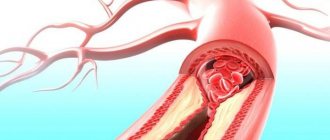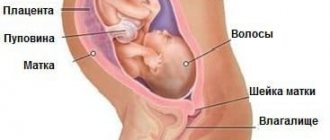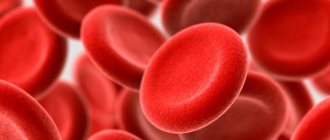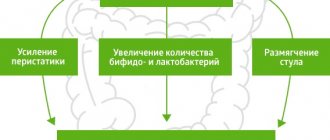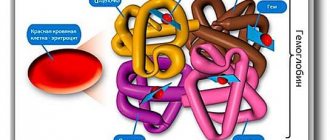In the female body, pregnancy initiates a radical restructuring, which often causes pathological deviations in some vital signs. But the results are not always above/below the norm - this is a sign of deviations and danger.
The diagnosis of “low hemoglobin” is observed in 80% of pregnant girls. This is a fairly common phenomenon that can be found even during normal pregnancy. The development of anemia is dangerous for the expectant mother and baby, but before you sound the alarm, you should understand the causes of the pathology. By identifying them, there is a chance to prevent the development of the disease without harming your health. Why does blood protein decrease?
Why do pregnant women need to monitor hemoglobin?
Why does the human body need hemoglobin? With its help, oxygen and carbon dioxide are transported in the blood. That is, hemoglobin is the most important microelement for the proper functioning of the respiratory function.
A child, while in the womb, also needs oxygen, but he cannot breathe on his own - gas exchange occurs through the placenta along with the blood. What happens if there is a deficiency of hemoglobin? In simple terms, the unborn child will experience oxygen deficiency .
In critical cases, oxygen deficiency in the baby in the womb can lead to asphyxia and subsequent fetal death. This is why it is so important to monitor hemoglobin levels - the normal course of pregnancy directly depends on this.
It is also worth mentioning that hemoglobin deficiency may also indicate a lack of B vitamins and folic acid. And this is fraught with an imbalance of sex hormones in the body of the expectant mother, which can cause self-abortion of the fetus (premature birth, when the body provokes it on its own, even though the child has not yet fully formed).
Normal blood content
The average hemoglobin level in a non-pregnant adult woman is 139 grams per liter of blood. During pregnancy, this figure decreases slightly. The following readings are not a deviation:
- first trimester – 132 grams per liter;
- second trimester – 120 grams per liter;
- third trimester – 112 grams per liter.
After childbirth, the hemoglobin level returns to normal, but this will take from 1 to 6 months (the recovery period for each woman may vary, but after the birth of the first child it is longer than after the second and all subsequent children).
In the first trimester, in particular, for 2–3 months, hemoglobin may increase slightly, which is due to the cessation of menstruation. This is also a normal phenomenon and is not a deviation from the norm - this is the physiology of the female body.
Negative consequences of low hemoglobin during pregnancy and methods of treating it
Working for two people, for a mother and her child, is very difficult and responsible. And not every pregnant woman’s body manages to cope with it. Therefore, some organs and systems often fail. Low hemoglobin during pregnancy is one of the most commonly diagnosed phenomena. But it should not be considered safe, because the risk for the normal development of the fetus increases significantly.
Signs of a low level
Hemoglobin deficiency in a pregnant or nursing mother can manifest itself in a very wide list of symptoms, and for each woman their combination can vary dramatically.
The most common signs are:
- general weakness and chronic fatigue;
- the appearance of problems with skin, nails, hair;
- pale skin;
- accelerated heartbeat (occurs with a significant deficiency of hemoglobin when the body experiences oxygen starvation);
- the emergence of an addiction to certain odors (most often the smell of paint, gasoline, acetone, various types of solvents, synthetic adhesives, motor oil, exhaust gases, and so on);
- tendency to toxicosis (especially noticeable in the early stages of pregnancy);
- signs of immunodeficiency (susceptibility to infectious diseases, manifestations of thrush, skin diseases, and so on);
- decreased taste sensitivity (also often develops against the background of toxicosis).
But it is worth considering that often hemoglobin deficiency is not accompanied by any symptoms at all. However, doctors still prescribe a blood test (almost every month) to monitor the level of hemoglobin in the blood of a pregnant woman.
General nutrition rules
To normalize hemoglobin levels in the blood as quickly as possible during pregnancy, the following recommendations must be followed:
- Provide sufficient iron for the body in the food you eat. In an adult, the daily norm is only 8–15 mg per day; in pregnant women it increases to 22–25 mg.
- Ensure that the body receives a sufficient amount of B vitamins, omega-3 unsaturated fatty acids, ascorbic acid, sodium, potassium, silicon, zinc - all these microelements increase the bioavailability of iron, that is, they help the body absorb it normally (if there is a deficiency of the same folate acids, the body practically does not absorb iron).
- Include foods and dishes with complex proteins in your diet - when digested, they break down into amino acids, which enter into a biochemical reaction with iron and vitamins, after which the hemoglobin molecule is created in the cell.
Doctors also recommend avoiding neuroses and stressful situations - they can make adjustments to the hormonal levels, which regulate the pregnancy process itself, as well as hematopoietic function.
Not all foods and drinks rich in iron and other essential microelements can be consumed during pregnancy. For example, turmeric and parsley are good for increasing hemoglobin. But they can also act as antispasmodics on smooth muscle , which also causes uterine contractions. Therefore, they should absolutely not be used during pregnancy.
Functions of hemoglobin during pregnancy
Anemia is a syndrome characterized by a reduced amount of hemoglobin in the blood and/or the number of red blood cells.
Hemoglobin is a protein structure that transports iron and oxygen to all internal organs. Hemoglobin itself is carried only by red blood cells.
Chemical formula and structure of the hemoglobin molecule
During pregnancy, a new organ is formed in a woman’s body - the placenta, which also requires abundant blood supply and nutrition for adequate life support for the fetus.
It provides the baby with nutrition, oxygen, protection from infections and immune reactions; Every day the baby consumes 30 grams of iron, and it is quite logical that the mother’s body experiences an iron deficiency.
Iron provides a number of vital functions in the body:
- Transport of oxygen to tissues in the composition of hemoglobin and red blood cells;
- Participates in hematopoietic processes - bone marrow uses iron to synthesize hemoglobin;
- Participates in mitotic processes - iron is part of the enzymes that synthesize DNA and divide cells;
- Synthesizes hormones, in particular those of the thyroid gland - TSH, T3 and T4;
- Provides cells with energy - iron delivers oxygen to energy protein molecules;
- Regulates immunity - iron controls the level of leukocytes;
- Provides detoxification of the body - iron is part of liver enzymes that destroy toxins.
Normally, the hemoglobin level should exceed 110 g/l.
If this indicator decreases, a diagnosis of anemia is made; 3 degrees are distinguished:
- 1st degree – hemoglobin 110 – 90 g/l;
- 2nd degree – 90 – 70 g/l;
- Grade 3 – below 70 g/l.
Also important are indicators in biochemical blood tests such as ferritin, transferrin and serum iron. Ferritin shows iron reserves in the body; its decrease indicates a true lack of iron - iron deficiency anemia, and its increase indicates any chronic disease that is accompanied by iron deficiency. Transferrins are involved in the transport of iron through blood vessels, and serum iron is part of the plasma.
Using these indicators, you can already learn about hidden and latent iron deficiency at the stage of preconception preparation.
In the case of a hidden deficiency, only ferritin will be reduced in the blood test; with a latent deficiency, all 3 indicators will be reduced.
This is a good signal to immediately correct your condition, since the chances of anemia occurring already in the 1st trimester of pregnancy are very high.
Symptoms of anemia in an expectant mother
Pregnancy with low hemoglobin can be completely asymptomatic, since symptoms with a decrease in hemoglobin are mostly nonspecific and occur almost immediately after a drop in hemoglobin levels.
State of weakness in a pregnant woman with low hemoglobin levels
These symptoms include the following:
- Weakness, increased fatigue and low performance;
- Cyanotic or pallor of the skin and visible mucous membranes, as well as attacks of dizziness;
- Tachycardia and shortness of breath even with minor physical or emotional stress;
- Increased brittleness of nails, especially on the hands. This symptom is called koilonychia;
- Pica – the emergence of specific taste preferences, for example, a craving for eating chalk or other inedible things;
- Excessive hair loss and increased fragility;
- Insomnia;
- Syncope or presyncope.
The first degree, as a rule, occurs without any visible manifestations. With the second degree of anemia, minor symptoms appear, to which women pay little attention.
Hair loss due to low hemoglobin during pregnancy
And only in the third degree there is a combination of symptoms that manifests itself quite clearly and forces a person with anemia to seek qualified medical help.
Most often, during pregnancy, anemia has the same form - iron deficiency.
However, there are many forms and varieties of anemia, such as hemolytic, aplastic, posthemorrhagic and others, but they occur not only in pregnant women, but in people with any predispositions.
Despite the fact that iron deficiency anemia occurs in women in most cases, differential diagnosis is strictly necessary, since therapeutic approaches for different forms of anemia have significant differences, and during pregnancy, any pathology of the hematopoietic system must be addressed immediately.
Causes of low hemoglobin during pregnancy
Reduced hemoglobin levels due to multiple pregnancy
Low hemoglobin during pregnancy causes: physiological changes in a woman’s body naturally lead to a decrease in hemoglobin levels; as the baby grows and the duration of pregnancy increases, the following series of changes occur:
- The volume of circulating blood increases significantly: a new organ is formed - the placenta, and with it the third circle of blood circulation; the fetus also develops its own hematopoietic organs, which daily take 30 mcg of iron ions from the woman’s body.
- Growing needs of the fetus: starting from the 20th week of pregnancy, the fetus actively gains weight, every week on average 100-150 g.
- Early toxicosis. While a pregnant woman’s body is being reconstructed to new principles of functioning, a large amount of energy consumption occurs in the body, and this requires the presence of active forms of iron.
- Hormonal changes. Throughout pregnancy, except for the final weeks, a woman’s body is dominated by the hormone progesterone and prolactin. These hormones suppress peristalsis and intestinal motility, which reduces the absorption of nutrients, including iron ions.
- Multiple pregnancy.
Among the non-physiological reasons, the following can be identified: a short period between pregnancies (less than two years), bleeding, intestinal dysbiosis, exacerbation of chronic diseases, infectious diseases, chronic stress, taking certain medications, deficiency of B vitamins and minerals (magnesium, calcium).
Possible complications of low hemoglobin
In case of a lack of hemoglobin, iron deficiency develops, which can lead to the development of the following undesirable consequences: first, the body's immune defense decreases, the number of red blood cells decreases, and signs of blood clotting disorders appear.
All this leads to a lack of oxygen, both in the body of the mother and the fetus, and there is no complete saturation with vitamins.
Low hemoglobin during pregnancy has very serious consequences for the child.
How does low hemoglobin during pregnancy affect the child?
- Intrauterine growth retardation: as a result of fetal hypoxia, its growth and development slows down, mainly the development of the nervous system and brain is inhibited.
- The risk of perinatal mortality and prematurity increases.
- The risk of infection of the membranes increases: the risk increases by 2.5 times.
- Miscarriages are 10% more likely to occur.
Low hemoglobin during pregnancy consequences for the mother.
Eclampsia due to low hemoglobin during pregnancy
Reduced hemoglobin during pregnancy, what threatens the mother?
- Preeclampsia and eclampsia. Iron deficiency leads to a decrease in protein production, liver function is impaired, and brain hypoxia occurs.
- The risk of premature birth increases.
- The likelihood of premature placental abruption increases.
- Weakness of labor.
- Infectious complications in the postpartum period.
- Hypogalactia.
Low hemoglobin during pregnancy in the third trimester is especially important, since the baby requires a lot of iron and childbirth is ahead.
Increasing hemoglobin
Low hemoglobin during pregnancy, causes, consequences, how to increase?
Treatment of anemia in pregnant women is carried out both with medications and a therapeutic diet.
Food includes: veal, liver, tongue, eggs, pomegranates, beets, peaches. Low hemoglobin during pregnancy, what to do?
What should you limit?
It is recommended to avoid the following foods during pregnancy, as they most contribute to a decrease in hemoglobin:
- Pasta. In fact, this includes everything that is prepared on the basis of wheat flour (without bran).
- Dairy products. Almost all of them contain calcium in fairly large quantities, which impairs the absorption of iron. This directly affects hemoglobin levels. This includes almost all types of cheeses, butter, sour cream, kefir, yoghurts and other dairy desserts, condensed milk, fermented baked milk.
- Chicken egg whites. They also impair the absorption of iron by interfering with biochemical reactions with it involving amino acids. Interestingly, consuming chicken proteins has virtually no effect on the concentration of iron and folic acid (unlike dairy products and any others that contain calcium).
You should also avoid eating greens during pregnancy. More precisely, you can include it in your diet, but in limited quantities. Parsley, dill, turmeric, basil - all these products are rich in vitamins and even iron, but they cause spasms of smooth muscles, which is extremely dangerous in the early stages of pregnancy.
During this period, it is better to receive vitamins in the form of multivitamin complexes - this will be much safer for the expectant mother and child.
Consequences of low hemoglobin and pregnancy complications
Many women do not take this diagnosis seriously and do not understand what complications anemia leads to. If left untreated, dangerous consequences may occur:
- Preeclampsia is a serious complication in late pregnancy, which is characterized by the appearance of edema, high blood pressure, and the appearance of protein in the urine. These symptoms are directly related to anemia. Due to iron deficiency, liver function and water metabolism are disrupted, and protein production is reduced. In severe cases, cerebral circulation is impaired, which is why the woman often has pain and dizziness, visual disturbances, nausea, and abdominal pain. Due to preeclampsia and eclampsia, pregnancy is terminated at any stage.
- The fetus lags behind in development. Due to hypoxia, the embryo grows and develops more slowly. This condition has a bad effect on the child’s brain.
- Premature birth. Due to anemia, a woman can give birth from 22 to 37 weeks.
- Premature placental abruption. In the absence of timely treatment, there is a risk of death of the embryo or mother.
- With severe anemia, in 10% of cases the fetus is born dead, as it dies inside the womb.
- Possible complications during childbirth: weak labor, uterine bleeding.
- High risk of uterine infection after childbirth.
- Low volume of breast milk or its complete absence.
Thus, anemia negatively affects the health of the expectant mother and child.
Other Important Recommendations
You can also increase hemoglobin using the following tips and recommendations:
- Include the following dessert in your diet: a mixture of dried apricots, raisins, and walnuts. To prepare a hemoglobin mixture, you will need to take 50–60 grams of the above components, grind them using a meat grinder, coffee grinder or blender and add honey (the same amount as the ground mixture). Store in the refrigerator, take 1 teaspoon 3 times a day. The course is at least 2 weeks, further – if necessary.
- Take a course of the following vitamin complexes (to choose from): Complivit iron, Perfectil, Sorbifer, Fenyuls. You should first consult with your doctor.
- It is also important to maintain a daily routine (activity/rest). The process of hematopoiesis itself mainly occurs at night during sleep. Accordingly, chronic insomnia can provoke hemoglobin deficiency, even if the pregnant woman follows a healthy diet.
Hemoglobin deficiency does not always indicate a lack of iron or certain vitamins. This condition can be caused by certain diseases. This even includes blood cancer. Therefore, if you suspect a hemoglobin deficiency, you should not delay going to the doctor. It must be remembered that for the unborn child this is many times more dangerous than for the expectant mother.
